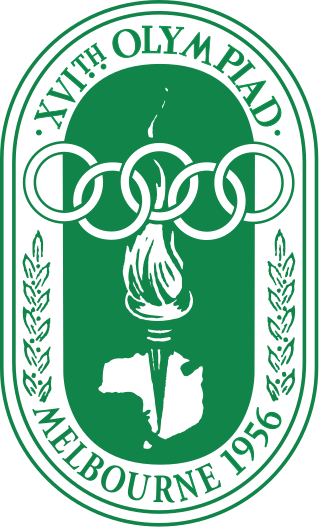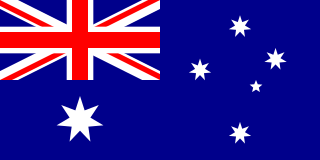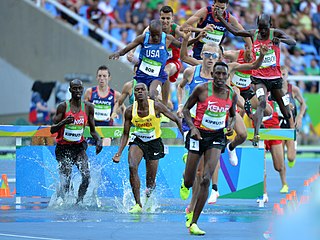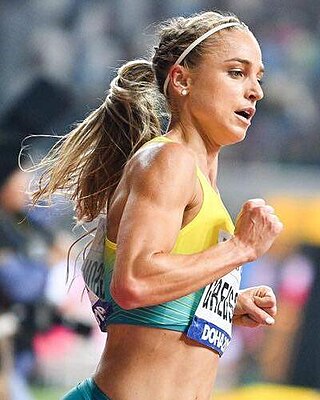
The 1956 Summer Olympics, officially the Games of the XVI Olympiad and officially branded as Melbourne 1956, were an international multi-sport event held in Melbourne, Victoria, Australia, from 22 November to 8 December 1956, with the exception of the equestrian events, which were held in Stockholm, Sweden, in June 1956.

Athletics has been contested at every Summer Olympics since the birth of the modern Olympic movement at the 1896 Summer Olympics. The athletics program traces its earliest roots to events used in the ancient Greek Olympics. The modern program includes track and field events, road running events, and race walking events. Cross country running was also on the program in earlier editions but it was dropped after the 1924 Summer Olympics.

The men's 2500 metres steeplechase was a track & field athletics event at the 1900 Summer Olympics in Paris. It was the first time that a steeplechase race was held at the Olympics. The race was held on July 15, 1900, on a 500-metre track. Six athletes from six nations competed in the shorter of the two steeplechase events. The 4000 metre steeplechase race was held one day later. The event was won by George Orton of Canada, the nation's first gold medal in athletics. Sidney Robinson of Great Britain took silver, while Jean Chastanié of France earned bronze.

Australia was the host nation for the 1956 Summer Olympics in Melbourne, Australia. However, due to Australian quarantine restrictions the equestrian events were held in Stockholm, Sweden. 294 competitors, 250 men and 44 women, took part in 140 events in 18 sports.

The steeplechase is an obstacle race in athletics which derives its name from the steeplechase in horse racing. The foremost version of the event is the 3000 metres steeplechase. The 2000 metres steeplechase is the next most common distance. In youth athletics, a distance of 1000 metres is occasionally used for steeplechase races.

India competed at the 1956 Summer Olympics in Melbourne, Australia. 59 competitors, 58 men and 1 woman, took part in 32 events in 8 sports. Their solitary medal, a gold, came in men's field hockey.

The 3000 metres steeplechase or 3000-meter steeplechase is the most common distance for the steeplechase in track and field. It is an obstacle race over the distance of the 3000 metres, which derives its name from the horse racing steeplechase.
Jerzy Chromik was a foremost long-distance runner from Poland.
Ernst Willy Larsen was a Norwegian athlete, who competed mainly in the 3000 metre steeplechase. He represented Ranheim IL.
Sándor Rozsnyói was a Hungarian athlete, who mainly competed in the 3,000-metre steeple chase.

The men's high jump was an event at the 1956 Summer Olympics in Melbourne, Australia. Twenty-eight contestants from 19 nations met on the morning of the first day of the athletic contests, on Friday November 23, 1956, and 22 cleared the qualifying height of 1.92 metres, to meet again in the afternoon. The maximum number of athletes per nation had been set at 3 since the 1930 Olympic Congress. The event was won by Charles Dumas of the United States, the nation's second consecutive and 11th overall victory in the men's high jump. Chilla Porter's silver was Australia's second medal in the event. Igor Kashkarov's bronze was the Soviet Union's first.
Philip Yates Coleman was a middle- and long-distance runner from the United States. He was born in Champaign, Illinois. He won the gold medal in the men's 3000 metres steeplechase event at the 1959 Pan American Games. Coleman attended Southern Illinois University (1948 - 1952, spent two years in the Army and becoming inter service steeplechase champion. He attended graduate school at the University of Illinois, meanwhile competing for The University of Chicago Track Club. He was a member of the 1956 and 1960 Olympic teams. He retired from running in 1960, wrote an article for Sports Illustrated "Idea of an Amateur", 1962, for which he was awarded the Mohammed Taher trophy by the International Olympic committee. With his thesis, "Mark Twain's Desperate Naturalism" completed, he received a PhD in Literature in 1964. He taught literature and served as dean at California University of Pennsylvania, retiring in 1998.
Trevor Anthony Vincent, is a former Australian long-distance runner, specialising in the 3000 metres steeplechase. In 1962 he competed for his native country at the Commonwealth Games in Perth, Western Australia, winning the gold medal in the 3000m steeplechase event, setting an inaugural Commonwealth Games record and breaking his own Australian record. He also competed at the 1964 Summer Olympics in Tokyo, Japan in the 3000 metres steeplechase event.

The men's 3,000 metres steeplechase event at the 1980 Summer Olympics took place from 26 to 31 July at the Lenin Stadium. A total of 32 athletes competed, with three qualifying heats and two semi-finals (24) before the final (12).

Genevieve Gregson is an Australian athletics competitor who specialized in the 3000 metre steeplechase but for the 2024 Olympics qualified for and ran for Australia in the marathon. She qualified for the Tokyo 2020 Olympics and ran 9:26.11 in her Women's 3000m steeplechase heat to qualify for the final. She fell, rupturing her Achilles tendon, and was unable to complete the race.

The steeplechase at the Summer Olympics has been held over several distances and is the longest track event with obstacles held at the multi-sport event. The men's 3000 metres steeplechase has been present on the Olympic athletics programme since 1920. The women's event is the most recent addition to the programme, having been added at the 2008 Olympics. It is the most prestigious steeplechase track race at elite level.

Stewart "Stewie" McSweyn is an Australian long-distance runner. He was a finalist in the men's 1500 metres in the Tokyo Olympics, and has also been a World Championships and Commonwealth Games finalist in the 3000 metres steeplechase, 5000 metres and 10,000 metres.
Ben Buckingham is an Australian track and field athlete who specializes in the 3000 metres steeplechase.

John Eamon Gay is a Canadian track and field Olympic Finalist who specializes in the 3000 metres steeplechase.

Matthew Clarke in Melbourne, Australia is an Australian Olympic athlete who competes in the 3000 metres steeplechase.













